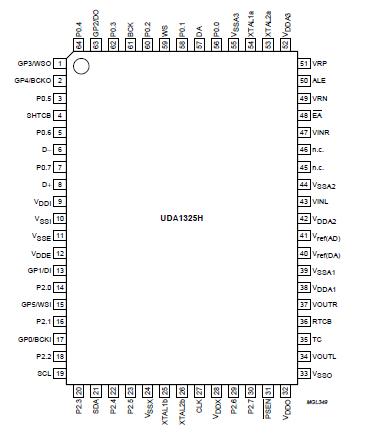Features: General
` High Quality USB-compliant Audio/HID device
` Supports 12 Mbits/s serial data transmission
` Fully USB Plug and Play operation
` Supports 'Bus-powered' and 'Self-powered' operation
` 3.3 V power supply
` Low power consumption with optional efficient power control
` On-chip clock oscillator, only an external crystal is required.
Audio playback channel
` One isochronous output endpoint
` Supports multiple audio data formats (8, 16 and 24 bits)
` Adaptive sample frequency support from 5 to 55 kHz
` One master 20-bit I2S digital stereo playback output,I2S and LSB justified serial formats
` One slave 20-bit I2S digital stereo playback input, I2S and LSB justified serial formats
` Selectable volume control for left and right channel
` Soft mute control
` Digital bass and treble tone control
` Selectable on-chip digital de-emphasis
` Low total harmonic distortion (typical 90 dB)
` High signal-to-noise ratio (typical 95 dB)
` One stereo Line output.
Audio recording channel
` One isochronous input endpoint
` Supports multiple audio data formats (8, 16 and 24 bits)
` Twelve selectable sample rates (4, 8, 16 or 32 kHz; 5.5125, 11.025, 22.05 or 44.1 kHz; 6, 12, 24 or 48 kHz) via analog PLL (APLL).
` Selectable sample rate between 5 to 55 kHz via a second oscillator (optional)
` One slave 20-bit I2S digital stereo recording input,I2S and LSB justified serial formats
` Programmable Gain Amplifier for left and right channel
` Low total harmonic distortion (typical 85 dB)
` High signal-to-noise ratio (typical 90 dB)
` One stereo Line/Microphone input.
USB endpoints
` 2 control endpoints
` 2 interrupt endpoints
` 1 isochronous data sink endpoint
` 1 isochronous data source endpoint.
Document references
` "USB Specification"
` "USB Device Class Definition for Audio Devices"
` "Device Class Definition for Human Interface Devices(HID)"
` "USB HID Usage Table".
` "USB Common Class Specification".Application· USB monitors
· USB speakers
· USB microphones
· USB headsets
· USB telephone/answering machines
· USB links in consumer audio devices.Pinout Specifications
Specifications
| SYMBOL |
PARAMETER |
CONDITIONS |
MIN. |
TYP. |
MAX. |
UNIT |
| All digital I/Os |
| VI/O |
DC input/output voltage range |
|
-0.5 |
- |
VDDE |
V |
| IO |
output current |
VDDE = 5.0 V |
- |
- |
4 |
mA |
| Temperature |
| Tj |
junction temperature |
|
0 |
- |
125 |
|
| Tstg |
storage temperature |
|
-55 |
- |
+150 |
|
| Tamb |
operating ambient temperature |
|
0 |
25 |
70 |
|
| Electrostatic handling |
| Ves |
electrostatic handling |
note 1 |
-3000 |
- |
+3000 |
V |
| note 2 |
-300 |
- |
+300 |
V |
Notes
1. Equivalent to discharging a 100 pF capacitor through a 1.5 k series resistor.
2. Equivalent to discharging a 200 pF capacitor through a 2.5 H series conductor.DescriptionThe UDA1325 is a single chip stereo USB codec incorporating bitstream converters designed for implementation in USB-compliant audio peripherals and multimedia audio applications. It contains a USB interface, an embedded microcontroller, an Analog-to-Digital Interface (ADIF) and an Asynchronous Digital-to-Analog Converter (ADAC).
The USB interface consists of an analog front-end and a USB processor. The analog front-end transforms the differential USB data into a digital data stream. The USB processor buffers the incoming and outgoing data from the analog front-end and handles all low-level USB protocols. The USB processor selects the relevant data from the universal serial bus, performs an extensive error detection and separates control information and audio information. The control information is made accessible to the microcontroller. At playback, the audio information becomes available at the digital I2S output of the digital I/O module or is fed directly to the ADAC. At recording, the audio information is delivered by the ADIF or by the digital I2S input of the I2S-bus interface.
All I2S inputs and I2S outputs support standard I2S-bus format and the LSB justified serial data format with word lengths of 16, 18 and 20 bits.
Via the digital I/O module with its I2S input and output, an external DSP can be used for adding extra sound processing features for the audio playback channel.
The microcontroller is responsible for handling the high-level USB protocols, translating the incoming control requests and managing the user interface via general purpose pins and an I2C-bus.
The ADAC enables the wide and continuous range of playback sampling frequencies. By means of a Sample Frequency Generator (SFG), the ADAC is able to reconstruct the average sample frequency from the incoming audio samples. The ADAC also performs the playback sound processing. The ADAC consists of a FIFO, an unique audio feature processing DSP, the SFG, digital filters, a variable hold register, a Noise Shaper (NS) and a Filter Stream DAC (FSDAC) with line output drivers. The audio information is applied to the ADAC via the USB processor or via the digital I2S input of the digital I/O module.
The ADIF consists of an Programmable Gain Amplifier (PGA), an Analog-to-Digital Converter (ADC) and a Decimator Filter (DF). An Analog Phase Lock Loop (APLL) or oscillator is used for creating the clock signal of the ADIF. The clock frequency for the ADIF can be controlled via the microcontroller. Several clock frequencies are possible for sampling the analog input signal at different sampling rates.
The wide dynamic range of the bitstream conversion technique used in the UDA1325 for both the playback and recording channel guarantees a high audio sound quality.

 UDA1325 Data Sheet
UDA1325 Data Sheet







